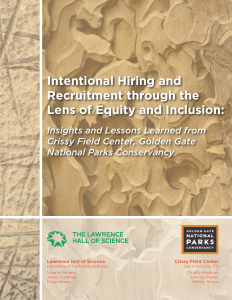The mainstream environmental education (EE) field continues to go through a period of reflection and reexamination in an attempt to overcome decades of practices that have resulted in a nearly homogenous white workforce (Taylor, 2014). Across environmental-related non-profits, foundations, and other entities, the workforce is disproportionately white, particularly in leadership roles (Taylor, 2014). In a 2018 study, leaders of EE organizations reported that they have a goal to hire more black and brown educators, and they cited three primary barriers to achieving this goal: 1) not enough people of color apply; 2) applicants of color that do apply rarely meet the hiring criteria; and 3) the nature of the job does not meet the needs of people of color (Romero et al., 2019). However, the same study found that current EE professionals of color found that these perceived challenges present a deficit-oriented framing that fails to acknowledge how the current practices of EE organizations may be reinforcing systemic barriers to entry.
In other words, the current hiring practices of many EE organizations are, unwittingly, pushing interested potential environmental education professionals of color away from the field before they can even enter. This finding resonates with researchers who continue to challenge organizations to be reflective in their hiring practices and to always consider how their practices may be deterring potential applicants, marginalizing current staff of color, and reinforcing the status quo (Roberts & Chitewere, 2011; Beasley, 2016; Taylor, 2018).
It is within this larger context that Crissy Field Center (the Center) at the Golden Gate National Parks Conservancy has been working to mitigate unconscious bias in their hiring practices for several years. We share this brief to provide an example of the introspection, intention, and attention to detail behind one organization’s journey toward a workforce that reflects the youth they serve and their organization-wide core values of equity and inclusion.
Acknowledgements
This brief is the second in our series resulting from a collaborative project, Working Towards Equitable Organizations, that is funded by the Pisces Foundation and the Clarence E. Heller Charitable Foundation, and would not be possible without the contributions of all the partners: Charity Maybury, Christy Rocca, and Francis Taroc of Crissy Field Center at the Golden Gate National Parks Conservancy; José González, founder of Latino Outdoors; Eric Aaholm of YES Nature to Neighborhoods; and Kim Moore Bailey, Laura Rodriguez, and Rena Payan of Youth Outside.
Our first brief, Examining Equitable and Inclusive Organizations in Environmental Education: Perspectives from the Field (Romero, Foreman, Strang, Rodriguez, Payan, and Moore Bailey, 2019), drew our attention to an important consideration: when examining recruitment and hiring practices, it is imperative for organizations to consider “all aspects of the hiring process, including job descriptions, qualifications, and interview committees,” and to ensure that “diversity goals” go beyond numbers to “articulate what equity and inclusion look like in all areas of the organization” (p. 6).
Recognizing the journey of the Crissy Field Center in examining and improving their own recruitment and hiring practices, the Lawrence Hall of Science conducted a series of interviews with Charity Maybury (Deputy Director, Crissy Field Center) and Ernesto Pepito (Associate Director, Crissy Field Center) to document their process. Charity, Ernesto, and Christy Rocca (Associate Vice President, Youth Programs and Services, Golden Gate National Parks Conservancy), reviewed the brief to ensure the narrative is authentic and reflects the experiences and voices of Crissy Field Center. The Lawrence Hall of Science offers gratitude to our co-authors for their time, thoughtfulness, transparency, willingness to share, and critical perspectives throughout the writing of this brief.
Lead funding for this study provided by the Pisces Foundation. Additional funding was provided by the Clarence E. Heller Foundation.

